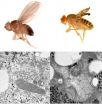Gastric bypass alters sweet taste function
2010-11-03
(Press-News.org) Gastric bypass surgery decreases the preference for sweet-tasting substances in obese rats, a study finding that could help in developing safer treatments for the morbidly obese, according to Penn State College of Medicine researchers.
"Roux-en-Y gastric bypass surgery is the most common effective treatment for morbid obesity," said Andras Hajnal, M.D., Ph.D., associate professor, Department of Neural and Behavioral Science and Surgery. "Many patients report altered taste preferences after having the procedure."
This surgery involves the creation of a small gastric pouch and bypassing a portion of the upper small intestine. Unlike other weight-reduction methods, it produces substantial and durable weight loss and significant improvements in obesity-related medical conditions including diabetes.
Study results in obese rats suggest that post-surgery changes in the gastrointestinal anatomy affect change in the brain that relate to taste.
Obese rats given gastric bypass surgery showed a reduced preference for high concentration sucrose water when compared to obese rats that did not have surgery. Researchers observed a similar decrease in preference with other sweet-tasting substances, but not for salty, sour or bitter substances. Researchers observed no change in preference in lean rats that had gastric bypass surgery.
The obese rats used do not have the ability to produce the receptor for feeling satiated shortly after a meal because they lack the gut hormone CCK-1. As a result, these rats consumed larger meals and, over time, became obese and developed type-2 diabetes. Interestingly, previous studies lead by the Penn State investigators found an increased sweet preference in these rats, which is also often seen in people struggling with weight management.
"It appears that an uncontrolled appetite may get further boost from altered taste functions during development of obesity and diabetes," Hajnal said. "How much of this vicious circle is due to changes in the neurons inside the brain, which receive taste sensations from the tongue and report to the higher order motivational brain centers, we don't know."
The researchers recorded the activity of 170 taste-responsive neurons in the brain. These showed a shift in the neurons' firing activity similar to the behavioral response, which was measured in lick rates of the rats within a ten-second time period. Neurons in the obese rats' brain responded more vigorously to higher-concentration sucrose water placed on the tongue when compared to lean rats. These effects were reversed by gastric bypass surgery and matched the response of lean rats -- a preference for lower concentration sucrose.
The rats that had gastric bypass surgery lost weight comparable to humans who received the surgery -- 26 to 30 percent of their weight -- and maintained the loss for a long period of time after surgery. Following surgery, the obese rats also showed a higher tolerance for glucose, indicating improvement in diabetes.
"This supports the applicability of this rat model of Roux-en-Y gastric bypass to humans and also suggests that the observed taste changes following the surgery were not related to 'human factors' such as awareness and compliance to dietary and behavioral interventions," Hajnal said.
The researchers published their findings in the October issue of the "American Journal of Physiology, Gastrointestinal and Liver Physiology." The National Institute of Diabetes and Digestive and Kidney Diseases and the National Institute of General Medical Sciences funded this work.
"These findings confirm obesity-related alterations in taste functions and demonstrate the ability of gastric bypass surgery to alleviate these modifications," Hajnal said. "We do not suggest, however, that the findings reported in this paper are the only neural consequences of gastric bypass surgery related to altered postsurgical food preferences. Nevertheless, understanding the underlying mechanisms by which gastric bypass surgery affects taste may help in identifying therapeutic targets that mimic the beneficial effects of the surgery on appetite control and food choices, without the risks and complications of an invasive surgical procedure."
INFORMATION:
Further research is needed to determine what causes the neural and behavioral changes, according to Hajnal.
Other members of the research team are Peter Kovacs, Ph.D., Department of Neural and Behavioral Sciences; Tamer Ahmed, M.D. and Katia Meirelles, M.D., Department of Surgery; Christopher J. Lynch, Ph.D., professor, Department of Cellular and Molecular Physiology; and Robert N. Cooney, M.D., Department of Surgery, Upstate Medical University, Syracuse, N.Y.
ELSE PRESS RELEASES FROM THIS DATE:
2010-11-03
This year's Salary Survey saw drops in salaries across the board with almost every speciality suffering a setback, some with dips as large as $20,000 (ecology) and $28,000 (virology).
However, a few select fields, namely bioinformatics, biophysics, biotechnology, and neuroscience, bucked the trend and actually posted salary increases this year. Whilst it is not easy to determine why these specialities saw salaries rise and others saw salaries cut, Mark Musen, head of the Stanford Center for Biomedical Informatics Research at Stanford University commented: "I've noticed ...
2010-11-03
WEST LAFAYETTE, Ind. - Researchers have learned the structure that results when an antibody binds to the West Nile virus, neutralizing the virus by locking up its infection mechanism. The information could help scientists develop a vaccine against the mosquito-borne disease.
The findings show precisely how a key part of the antibody, called the antigen binding fragment, or Fab, attaches to two adjacent protein molecules that make up the virus's outer shell. This "crosslinking" attachment between molecules is repeated over the entire shell, interlocking the 30 molecular ...
2010-11-03
Winston-Salem, N.C. – Researchers for the first time have shown that drinking beet juice can increase blood flow to the brain in older adults – a finding that could hold great potential for combating the progression of dementia.
The research findings are available online in Nitric Oxide: Biology and Chemistry, the peer-reviewed journal of the Nitric Oxide Society and will be available in print soon. (Read the abstract.)
"There have been several very high-profile studies showing that drinking beet juice can lower blood pressure, but we wanted to show that drinking beet ...
2010-11-03
TORONTO, Ont., Nov. 2, 2010-Severely injured patients should be transported directly from the scene of an accident to a trauma center, even if it means bypassing a closer hospital, according to new research that shows this results in a nearly 25 per cent lower death rate.
However, even though 80 to 85 per cent of people in North America live within a one-hour drive or flight of a trauma center, 30 to 60 per cent of severely injured patients are still taken to the nearest hospital.
Researchers led by Dr. Avery Nathens, trauma director at St. Michael's Hospital in Toronto, ...
2010-11-03
A study by the team headed by Lluís Ribas de Pouplana, ICREA professor at the Institute for Research in Biomedicine (IRB Barcelona), has been chosen as "Paper of the week" in the December issue of the Journal of Biological Chemistry, which is already available online. The article describes the discovery of a new protein in the fly Drosophila melanogaster (fruit fly) that is crucial for mitochondria. The removal of SLIMP in these flies leads to aberrant mitochondria and loss of metabolic capacity, thus causing death.
The study, whose first author is Tanit Guitart, a PhD ...
2010-11-03
A University of Toronto study shows that visual attention -- the brain's ability to selectively filter unattended or unwanted information from reaching awareness -- diminishes with age, leaving older adults less capable of filtering out distracting or irrelevant information.
Further, this age-related "leaky" attentional filter fundamentally impacts the way visual information is encoded into memory. Older adults with impaired visual attention have better memory for "irrelevant" information. The research, conducted by members of U of T's Department of Psychology, will ...
2010-11-03
Canadians who work night and rotating shifts are almost twice as likely to be injured on the job than those working regular day shifts, according to a study by researchers at the University of British Columbia.
The study, published in the current issue of the Scandinavian Journal of Work, Environment and Health, examined data on more than 30,000 Canadians collected as part of Statistics Canada's Survey of Labour and Income Dynamics and compared results between workers involved in different types of shift work from 1996-2006. It shows that while the overall rate of work ...
2010-11-03
Every person emits the equivalent of approximately two tonnes of carbon dioxide a year from the time food is produced to when the human body excretes it, representing more than 20% of total yearly emissions. That is what a study by the Universidad de Almería says, confirming for the first time that human excrements contribute to water pollution, primarily with nitrogen and phosphorus.
A team of researchers from the Universidad de Almería (UAL) has estimated the environmental impact of the Spanish diet and role that human excrements play in the life cycle of food. It is ...
2010-11-03
A new report from the Energy Biosciences Institute (EBI) in Berkeley projects that development of cost-competitive algae biofuel production will require much more long-term research, development and demonstration. In the meantime, several non-fuel applications of algae could serve to advance the nascent industry.
"Even with relatively favorable and forward-looking process assumptions (from cultivation to harvesting to processing), algae oil production with microalgae cultures will be expensive and, at least in the near-to-mid-term, will require additional income streams ...
2010-11-03
Amsterdam, 2 November, 2010 - An investigation conducted in the context of the Swiss National Research Programme (NRP50), Endocrine Disrupters: Relevance to Humans, Animals and Ecosystems, demonstrates for the first time that internal exposure of humans to cosmetic UV filters is widespread.
In the course of the Summer and Fall 2004, 2005 and 2006 (3 cohorts), human milk was sampled by mothers who had given birth at the University Women's Hospital in Basel. The participants filled out a detailed questionnaire with general questions and, as special feature, in depth questions ...
LAST 30 PRESS RELEASES:
[Press-News.org] Gastric bypass alters sweet taste function


